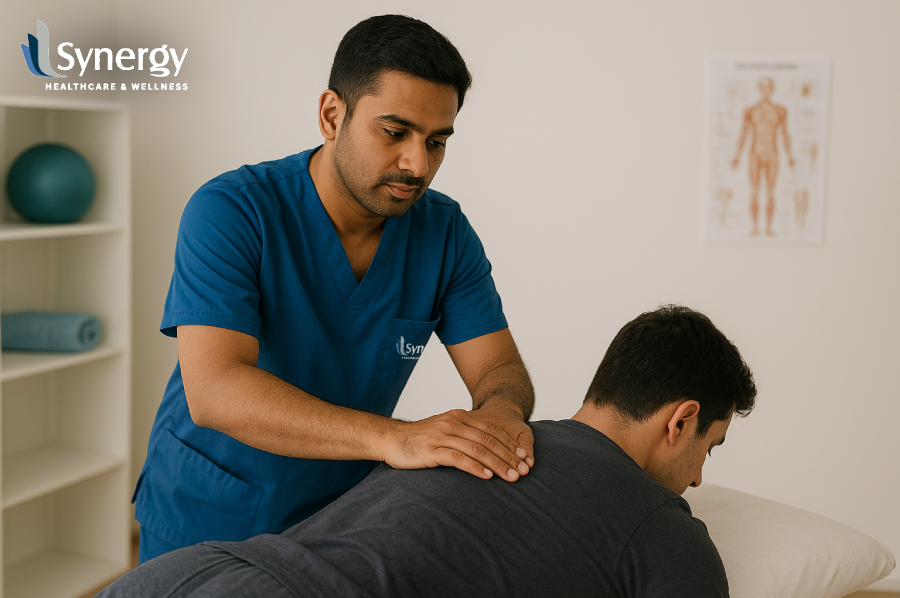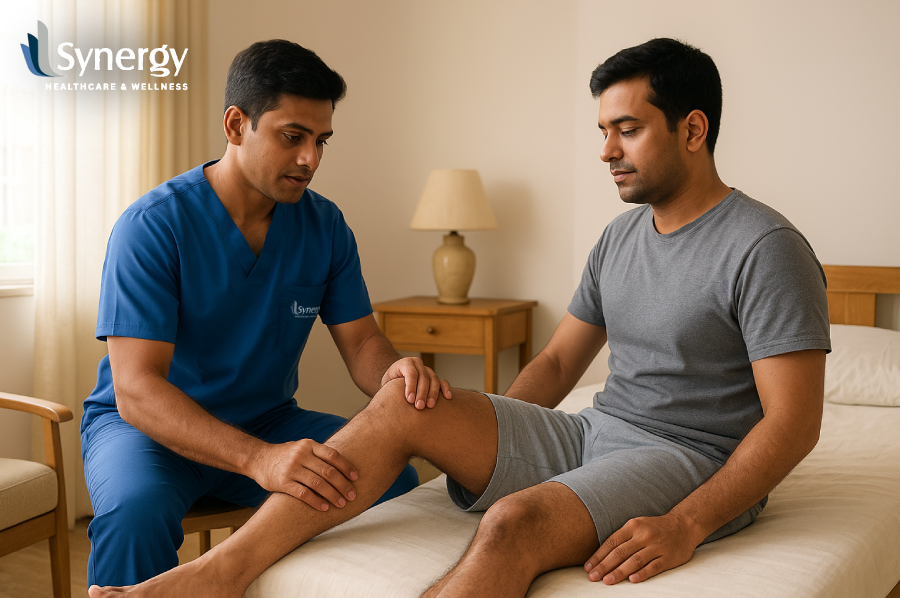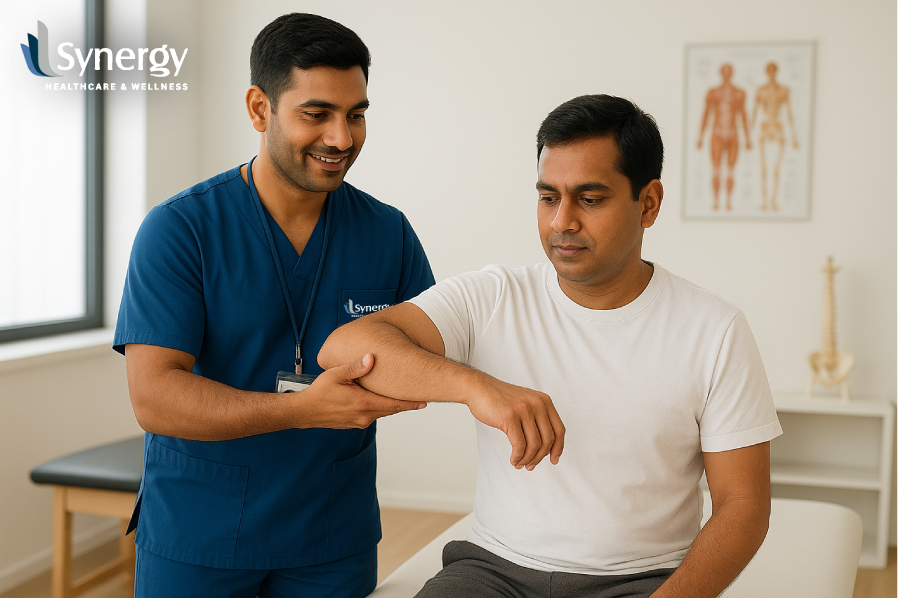Physiotherapy vs Chiropractic: Which Works Better for Pain Relief?

When pain limits work, sleep, or family time, it is natural to ask which route will help faster. You may hear strong opinions for one or the other. It helps to know what each approach actually does, what the evidence says, and how to choose a plan you can keep. The notes below compare the two in plain language so you can make a steady, sensible start about physiotherapy vs chiropractic. Let’s Begin Both approaches help many people in pain. Physiotherapy builds capacity with exercise, movement retraining, and education, using manual techniques when helpful. Chiropractic care relies more on spinal manipulation, with advice or exercises added by some clinicians. Research and guidelines show that manipulation can relieve pain for some conditions, yet outcomes are often similar to other options when care is planned and reviewed. Active rehabilitation sits at the centre of most modern guidance, which aligns closely with physiotherapy’s core strengths. Physiotherapy vs Chiropractic: Which Works Better for Pain Relief? It is reasonable to ask which path will work faster. A fair answer looks past labels and checks what each method actually does, what the evidence says, and how well the plan fits your day. The notes below compare the two in plain language so you can choose a course you can keep. What Each Approach Focuses On Physiotherapy uses assessment, targeted exercise, movement coaching, and education. Manual therapy is used to reduce irritability and improve motion, but the engine of change is progressive practice you can repeat at home and at work. Chiropractic care places a stronger emphasis on spinal manipulation to improve joint motion and reduce pain. Many chiropractors also provide advice and exercises, yet manipulation remains the signature technique in most visits. Large guidelines encourage using any manual method as part of a broader package that includes exercise, not as a stand-alone fix. What To Expect From A Good Course Of Care You should leave the first visit with a plain-language explanation of the problem, two or three short exercises with exact sets and repetitions, and advice for work, travel, sleep, and chores. Reviews should track a few simple numbers, such as pain on a 0 to 10 scale, time to stand from a chair five times, single-leg balance, or reach in degrees. When those numbers improve, your plan should advance. When they stall, the plan should change. Which Suits Which Goals If you prefer an exercise-led path with manual support as needed, physiotherapy is a natural fit. If you prefer a manipulation-led start, chiropractic care may suit you, provided it evolves toward active work. Choose the plan that serves your day. The right choice is the one you can follow through for several weeks without missing sessions. Practical Plans for Lasting Recovery At Synergy Healthcare and Wellness, your plan is built for daily life. We begin with a careful consultation and a movement screen. Sessions combine practical education, targeted exercise, and manual techniques when indicated. We teach you how to scale effort, fit practice into a busy week, and judge progress with simple measures you can repeat at home. If you prefer some hands-on care at the start, we use it alongside an active programme so the gains last. Summing Up Both physiotherapy and chiropractic care can reduce pain for common spine problems. The strongest and most consistent message from modern guidance is to keep active care at the centre and use manual therapy as support. That design is the natural shape of physiotherapy. If you want skills you can use independently and results that hold during busy weeks, an exercise-led physiotherapy plan, with selective hands-on work, is a sound first choice. FAQ’s 1. Which is better for back pain, physiotherapy or chiropractic? On average, the outcomes are similar when treatment is active and reviewed. Most guidelines place exercise and education at the core, with manual therapy as an adjunct, which maps closely to physiotherapy. 2. Is spinal manipulation safe? Serious complications are rare, but any manual technique should follow screening and consent. If you are unsure, start with an exercise-led plan and add manual therapy if needed. 3. How soon will I notice a change? Many people feel steadier within a few sessions, then see larger functional gains over weeks as practice becomes consistent. Timelines vary by condition and workload. 4. Can I mix the two approaches? Yes. Some people begin with short-term hands-on relief and then move to a clear strengthening plan. The key is to keep the active component central so improvements last.
Physiotherapy Myths vs Facts: What You Should Know

Misunderstandings about physiotherapy often delay recovery. This article lists common myths people hold, explains why they are misleading, and sets out the practical facts. Use it to choose sensible steps, ask better questions, and follow a plan you can keep. Let’s Begin When pain interrupts work or family life, people often try quick fixes. A tip from a friend, a video online, or a bold claim can sound convincing. Good care begins with clear thinking. If you have been searching for Physiotherapy Myths, Common Physiotherapy Misconceptions, or Physiotherapy Facts, use the notes below to test what you hear and to choose actions that suit your body. Physiotherapy Myths vs Facts Myth 1: Physiotherapy is just massage or heat Some people expect only hands-on relief or a few minutes with a machine. These may ease discomfort for a short time. The fact is that lasting change comes from learning how to move, building strength, and practising safely at home. Manual work and modalities can support this, but they do not replace it. Myth 2: You must stop all activity until pain is zero A brief rest can calm a flare, yet a long rest weakens muscles and stiffens joints. The fact is that gentle, graded movement helps most problems. The right dose is the amount you can repeat tomorrow without a setback. Myth 3: One or two sessions should fix it Tissues adapt over weeks. A quick improvement may happen, but durable results need steady practice and review. Expect a clear plan, a timeline, and checkpoints rather than a single miracle session. Myth 4: Treatment has to hurt to work Sharp pain is not a sign of progress. Productive exercise feels like effort, not injury. If symptoms spike and linger, the load is too high or the movement is not right. Good plans adjust early. Myth 5: Machines cure faster than exercise Ultrasound, IFT, and taping can be useful in select cases. They reduce symptoms for a period. The fact is that capacity improves when you strengthen, stretch as needed, and change unhelpful habits. Devices cannot do your repetitions for you. Myth 6: A scan gives the full answer Reports often list age-related changes seen in many people without pain. Decisions should combine your story, the examination, and your response to a trial of care. Scans are helpful when red flags or specific injuries are suspected. Myth 7: Everyone gets the same exercise sheet Two people with the same diagnosis can have different limits and goals. A desk worker and a mason will not need the same plan. Your programme should match your stage, your work, and the movements you want to regain. Myth 8: Therapy starts only after the wound is fully healed After many surgeries, early guided movement is part of healing. The programme respects precautions and builds gradually. Waiting too long can make stiffness harder to reverse. Your therapist will time each step with your surgeon’s advice. Myth 9: Older adults cannot gain strength or balance Age changes tissues, but improvement is possible at every stage. With the right dose and regular practice, strength, mobility, and confidence can rise together. Progress is measured in function, not only in the gym. Myth 10: Core exercises alone fix back pain A strong trunk helps, but backs are influenced by hips, mid-back mobility, sleep, stress, and workload. Well-rounded plans work better than any single focus. Myth 11: Posture alone causes pain There is no perfect sitting or standing pose for the entire day. Bodies prefer variety. Change positions often, break up long tasks, and build strength so you tolerate the day better. Myth 12: Belts, braces, and supports solve the problem Supports can help with short tasks. Over-reliance reduces muscle activity. The aim is to use them briefly while you train your body to handle the load on its own. Myth 13: Lifting weights is harmful if joints hurt Heavy, sudden lifts can provoke symptoms, but controlled strength training is one of the best tools for joint health. Start light, learn good form, and progress slowly. Myth 14: Home programmes do not work They work when they are clear, short, and repeated. Two or three drills with exact sets and repetitions, practised on most days, often beat long, complicated routines that are hard to keep. Myth 15: Physiotherapy is only for athletes or after injuries Therapy also prevents problems, supports long-sitting jobs, guides a safe return to sport, and helps long-term conditions such as arthritis. You do not need to wait for a crisis to ask for help. Goal-Oriented Physiotherapy Made Practical At Synergy Healthcare and Wellness, we keep care practical. Your first visit includes a careful interview and a movement screen. Together, we choose two or three goals that matter in daily life. Once consultation is complete, we begin sessions, which may include manual techniques when applicable. However, the focus is on teaching form, pacing, and simple ways to incorporate practice into a busy week. We offer clinic and home options and adjust the plan as you improve. Summing Up Myths grow when people are unsure. Facts give you a calmer path. When you understand why movement helps, how to dose exercise, and when to seek tests, you stop chasing quick fixes and start building strength that lasts. Keep the plan simple, be consistent, and let measured progress guide the next step. FAQ’s 1. Is soreness after new exercises normal? Mild, short-lived soreness can be expected. Sharp pain or symptoms that last beyond the limits you agreed means the load should be reduced or the movement changed. 2. When is imaging necessary? Scans are considered when specific signs suggest a fracture, significant ligament injury, nerve compromise, or other red flags. 3. Can I continue yoga or gym work during treatment? Yes, with sensible adjustments. Your plan will include safe substitutes and a progression so you remain active without provoking symptoms. 4. How soon should I expect a change? Many people notice early improvements in comfort or confidence within a
Home Physiotherapy in Chennai: Is It Worth It?

For many people, getting to a clinic is the hardest part of recovery. Home physiotherapy removes that barrier and brings care to your living room. It saves travel time, suits family routines, and lets your therapist tailor exercises to the furniture, stairs, and spaces you use every day. The value comes from steady practice, fewer missed sessions, and practical guidance that fits real life. If you searched for Home Physiotherapy In Chennai, Physiotherapy At Home Chennai, or Benefits Of Home Physiotherapy, this article sets out what to expect and how to decide. Let’s Begin Pain and stiffness can drain energy before the day even starts. Adding traffic, parking, and long hours at work makes regular clinic visits difficult. Home physiotherapy offers another path. The therapist assesses you at home, sets a plan you can carry out with the things you already own, and checks that daily movements are safe. For many conditions, this is not a second choice. It is the simplest way to build consistency. What home physiotherapy actually involves A home visit is a structured clinical session. Your therapist begins with a careful history, then checks range of motion, strength, balance, and movement patterns. Portable tools may be used, but most of the work is active. You learn positions that ease pain, techniques to reduce strain in daily tasks, and a short routine with clear instructions. The best part is context. If a chair is too low, you adjust it together. If bed height makes getting up difficult, you practise a safer method right there. Who is a good candidate People recovering after surgery often benefit because travel is tiring and precautions matter. Older adults do well when familiar surroundings reduce the fear of falling. New parents, caregivers, and professionals with long commutes appreciate the time saved. Home physiotherapy also helps when pain itself makes sitting in a vehicle or waiting in a lobby uncomfortable. Children may engage better at home with familiar toys and shorter, focused drills. How a typical home visit runs The first session sets the plan. You discuss what activities matter most, such as climbing stairs without pain or turning the neck comfortably while riding a two-wheeler. The therapist examines you, explains the findings in plain words, and demonstrates two or three starter exercises with exact sets and repetitions. You practise them under supervision so that form and breathing are correct. The visit ends with advice on posture, sleep positions, and how to schedule practice around meals and work. Reviews build on this start, progressing the load and adding variety as you improve. Is it as effective as clinic care? For many musculoskeletal and post-surgical conditions, yes. Recovery depends on the right plan, correct technique, and regular practice. Those ingredients can be delivered at home. Clinics are useful when specialised machines or large equipment are required or when multiple therapists need to see you on the same day. Many patients follow a hybrid approach. Early sessions happen at home for comfort and safety, then occasional clinic visits are added for advanced testing or progress checks. Costs, time, and real value Home care may include a travel component in the fee, but it often saves money and stress by cutting missed appointments and extra rides. You also gain the presence of a family member who can learn how to assist safely. Because your routine is designed in the room where you will do it, the plan tends to stick. Consistency is what turns exercises into results. Safety and quality checks Good providers verify identity, qualifications, and background. You can expect clear communication, punctuality, and simple hygiene practices, such as hand washing and equipment sanitation. Your therapist will also scan the room for loose rugs, poor lighting, and clutter that could raise fall risk. If any exercise causes sharp pain or numbness, the plan is adjusted that day. Preparing your space You do not need a gym. A firm chair without wheels, a stable table edge, a mat, and a belt or towel are enough for most programmes. Keep a bottle of water nearby and ensure there is good lighting. Pets can be moved to another room during balance work. Small details make practice calm and repeatable. How progress is measured at home Numbers matter. You and your therapist can track pain on a 0 to 10 scale, shoulder reach in degrees, time to stand from a chair five times, single-leg balance time, or steps per day. These measures are simple to repeat in the same corner of the room, so you see change rather than guess at it. When the numbers improve, your exercises advance to build resilience. Get Home Physiotherapy in Chennai with Structured Support Synergy Healthcare and Wellness provides home physiotherapy across Chennai with a straightforward process. We begin with a phone triage to understand your needs and confirm whether you are suitable for home care. The first visit includes a full assessment, explanation of findings, and a written plan with video support where helpful. Sessions combine manual techniques when indicated with targeted exercise and practical coaching for daily tasks such as stair use, floor sitting, and desk setup. Caregivers are welcome to observe so they can lend a hand safely. If your progress would benefit from specific clinic-based testing, we arrange that as part of the same pathway. Summing Up Home physiotherapy is not only convenient. It is a sensible way to turn advice into daily habits that last. When treatment fits your space, your schedule, and your family’s rhythm, you are more likely to keep going. For many conditions, it is the most direct route to fewer symptoms and better movement. If you prefer a mixed plan, combine home sessions with occasional clinic reviews. The right choice is the one you can sustain. FAQ’s 1. Do I need special equipment for home sessions? No. A chair, a mat, and a towel are enough for most programmes. Your therapist will bring any extra tools needed. 2. How many sessions per week
Top 10 Questions to Ask Your Physiotherapist Before Treatment

Walking into your first physiotherapy appointment can feel uncertain. You know something hurts or does not move as it should, yet you may not know what questions to ask your physiotherapist. Clear questions help you understand the plan, feel confident about your part in recovery, and avoid delays. Let’s Begin When pain lingers, most people want quick relief and straight answers. A good consultation does both. It explains what is wrong in plain words and gives you a routine you can actually follow. If you are unsure what to ask, start here. The questions below help you understand the diagnosis, the timeline, and how to handle daily tasks without making things worse. What Your First Consultation Should Include Expect three parts. How To Prepare So The Plan Fits Your Routine Write down the top three activities you want to regain, such as sitting cross-legged for prayer, squatting to pick up items, or riding a scooter without pain. Note what increases your symptoms and what eases them. Bring past reports if you have them, but do not worry if you do not. Wear comfortable clothes so you can move freely. Think about your weekly schedule. A short routine done well every day beats a long routine you cannot keep. Questions To Ask Your Physiotherapist Before Treatment Begins After The Visit: Keeping Steady Progress At Home Keep the plan visible where you practise. Mark each day you complete the routine. If pain rises above the level you agreed or lasts longer than expected, reduce the load and inform your therapist. Small adjustments made early prevent setbacks. As you improve, your plan should evolve from relief to strength and then to resilience for daily life. Synergy Healthcare and Wellness: For Personalised Care and Rehabilitation At Synergy Healthcare and Wellness, Chennai, your care follows a clear path. The consultation maps your symptoms and priorities. Physiotherapy sessions combine hands-on techniques when indicated with targeted exercise and pain-relief strategies. Rehabilitation builds range, strength, and balance in steps that match your schedule. Strengthening programmes are available if you wish to go beyond recovery and build long-term resilience. Every plan is individual and reviewed against measurable goals. Summing Up Good care is a partnership. When you ask focused questions, you leave with a plan you understand and a routine you can keep. Bring this set to your first session and use it at each review. Progress feels smoother when the steps are clear, and the work fits your day. FAQ’s 1. Do I need scans before starting treatment? Not always. Many conditions can be assessed accurately with history and movement tests. Your therapist will advise if imaging is needed. 2. How often should I come in at the start? Many people benefit from closer follow-up during the first two to three weeks, then fewer visits as home practice becomes consistent. 3. What if an exercise increases pain? Mild soreness that fades within a day can be normal when you begin. Sharp pain or soreness that lasts longer than agreed signals a need to adjust the load or technique. 4. Can I continue working out or doing yoga? Often yes, with modifications. Ask for safe substitutes that protect healing while keeping you active.
What Is Physiotherapy? A Beginner’s Guide for Patients

Have you ever felt limited by pain, stiffness, or an injury that made even simple tasks difficult? These moments remind us of the importance of movement in everyday life. This is where physiotherapy becomes essential. More than a treatment for pain, physiotherapy is a science-driven approach that helps people recover, regain strength, and prevent further problems. If you have searched for What Is Physiotherapy or wondered about the true physiotherapy meaning, this guide explains everything you need to know. Physiotherapy Meaning Explained Physiotherapy originates from the Greek words physis (meaning “nature”) and therapeia (meaning “treatment”). Put together, it reflects treatment through natural methods of movement, exercise, and manual techniques. In modern healthcare, physiotherapy refers to the use of physical methods rather than surgery or heavy reliance on medicines to treat pain, restore strength, and improve mobility. It combines medical knowledge, hands-on skills, and structured exercise programmes to deliver lasting results. Put simply, physiotherapy explained is this: it is the science of helping people move, recover, and stay active, with techniques tailored to the individual. Understanding What is Physiotherapy: A Complete Beginner’s Guide Who Provides Physiotherapy? Physiotherapy is delivered by qualified and licensed physiotherapists who complete years of specialised education and clinical training. They are skilled in: Physiotherapists work in a wide range of settings, including: They often collaborate with doctors, orthopaedic surgeons, and occupational therapists to provide comprehensive, evidence-based care. What Does a Physiotherapist Do? What happens during a physiotherapy session? A physiotherapist begins with a detailed assessment of your health, lifestyle, and symptoms. This step is crucial, as it identifies not only where the pain lies but also what causes it. Based on this, the physiotherapist may use a combination of: The physiotherapist’s role is not only to treat pain but also to guide patients towards long-term independence and confidence in movement. When Do You Need Physiotherapy? When should you consider physiotherapy? The answer is broader than most people realise. It is not limited to athletes or patients recovering from operations. You may need physiotherapy if you notice: Physiotherapy is equally valuable as a preventive measure. Office goers benefit from posture correction, runners use it to avoid overuse injuries, and older adults rely on it to reduce the risk of falls. Why Physiotherapy Is Important Why is physiotherapy important? Because being able to move without pain is central to everyday life. If you cannot bend your knee, lifting a child or climbing stairs becomes difficult. If your back aches constantly, even sitting at work can feel like a struggle. Physiotherapy matters because it: It is not just about recovery; it is about helping people enjoy life without being limited by their bodies. How Can One Benefit from Physiotherapy? Physiotherapy is suitable for almost everyone, not just those with injuries. It supports recovery, prevention, and long-term health. In short: physiotherapy is a safe, evidence-based treatment that helps people move better, recover faster, and stay active at every stage of life. Where Can You Get Expert Physiotherapy in Chennai? If you are looking for the best physiotherapy care that combines expert treatment with long-term recovery, we at Synergy Healthcare and Wellness are here to guide you every step of the way. We follow a clear, structured pathway that ensures recovery is safe, effective, and lasting: Individually Suggested Exercises Every patient receives a tailored exercise plan based on their condition and goals. This may include: These steps ensure that you get a complete recovery plan designed for long-term results. Summing Up Physiotherapy isn’t just about getting rid of pain. It’s about giving you back the ability to move freely, build strength, and feel confident in your own body again. Through a precise combination of hands-on care and targeted exercises, recovery becomes a safe and reliable process. No matter the challenge – be it from an accident, an operation, or a persistent health issue; physiotherapy provides a straightforward and effective solution. It works by addressing the root cause, reinforcing your body’s capabilities, and ultimately, ensuring a higher quality of life. FAQ’s 1. What exactly does physiotherapy treat? Physiotherapy helps with muscle, joint, and movement problems, including back pain, knee injuries, sports strains, arthritis, and recovery after surgery. 2. How many sessions will I need? It depends on the condition. Some patients feel better in a few sessions, while others may need several weeks of guided rehabilitation. 3. Do I need a doctor’s referral to see a physiotherapist? No, most patients can book an appointment directly with a physiotherapist. Referrals are only needed in some hospital settings. 4. Will physiotherapy exercises be the same for everyone? No, exercises are always individualised. They are chosen based on your age, condition, and goals to ensure safe and effective recovery. 5. Does physiotherapy only involve exercises? No. Treatment may include manual therapy, pain-relief techniques, education on posture, and in some cases electrotherapy, alongside exercises.
